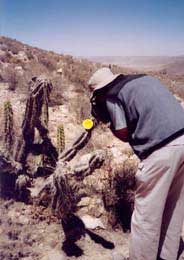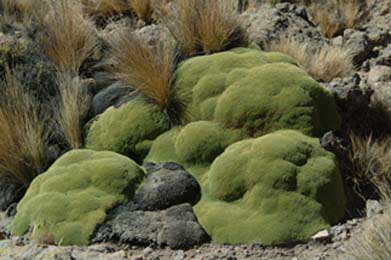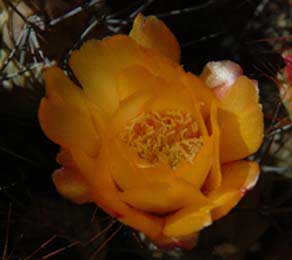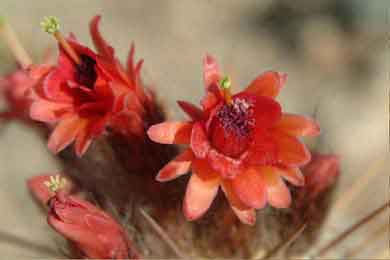
|
Spring
in Northern Chile
by Kay Quijada Traveling with Joe and 6 other “plant people” from the San Francisco area, we flew to the northern coastal city of Arica, Chile, and immediately headed east towards Lauca National Park in the Andes. We stayed in the village of Putre, elevation 11,500 feet, to help acclimatize quicker to the higher altitude of the Andes. From Putre, we took day trips up to the thin air of the altiplano (highlands) of Lauca. Spectacular views were everywhere. There were snow-covered volcanoes, wild herds of vicunas, rock-dwelling vizcachas, a lake with pink flamingos, colorful hills, and the bluest sky we’d ever seen.
We were amazed to see the green cushion-like plant called Azorella compacta, growing in the high desert altitudes of 14,000 to 15,000 feet. Traveling around in the high elevations we saw a few cactus; Eulychnia, Maihueniopsis, and Oreocereus species. On the way back to Arica we traveled through an area of enormous sand dunes where a number of stately Browningina candelaris grew.
We then flew south to the coastal city of Antofagasta and drove south into the beautiful Atacama Desert to Copiapo. One of the interesting sights seen in the Atacama Desert is the process of natural plant death. The Atacama is almost barren of bacteria. This fact became apparent to us as we realized the piles of white ash found around dead plants was not from burning, but from the very slow process of plant material disintegration due to low populations of bacteria. Since then, I’ve read that the plant disintegration process in the Atacama may take decades. As we made our
way around the coastal and desert canyons from Taltal to
Caldera, we managed to see a number of Copiapoa
and Eulychnia species (some blooming), a Cistanthe species
with red pompom flowers, Deutercohnia chrysantha, Oxalis
gigantea, beautiful scenery, and braying
wild Guanacos. Chile
is a spectacular place, indeed. |



